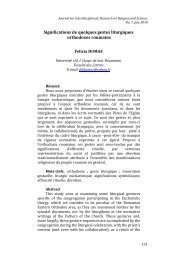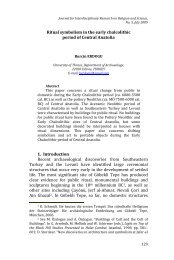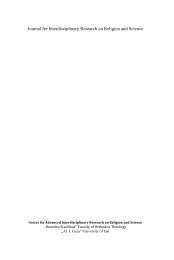Religious Dualism: Some Logical and Philosophical Difficulties
Religious Dualism: Some Logical and Philosophical Difficulties
Religious Dualism: Some Logical and Philosophical Difficulties
You also want an ePaper? Increase the reach of your titles
YUMPU automatically turns print PDFs into web optimized ePapers that Google loves.
AFLOROAEI - <strong>Religious</strong> <strong>Dualism</strong>: <strong>Some</strong> <strong>Logical</strong> <strong>and</strong> <strong>Philosophical</strong> <strong>Difficulties</strong><br />
procosmic; Gnosticism develops a moderate dualism, being<br />
both eschatological <strong>and</strong> procosmic; Manicheism is radical <strong>and</strong><br />
anticosmic; Bogomilism is moderate, eschatological <strong>and</strong><br />
anticosmic; the Cathars’ conception has a radical <strong>and</strong> a<br />
moderate form, both of which are anticosmic 20 . The distinction<br />
between eschatological <strong>and</strong> cyclic dualism leads to another<br />
couple of opposites, namely procosmism (when the world is<br />
essentially good) <strong>and</strong> anticosmism (when the world is<br />
essentially evil). Naturally, the latter invariant (procosmism-<br />
anticosmism) is related to man’s attitude towards the existent<br />
values. We may discover a positive attitude, when salvation is<br />
considered possible, or a negative one, when the traumas of<br />
creation <strong>and</strong> of human life are considered insoluble <strong>and</strong> the<br />
great conflicts of existence - endlessly repeated.<br />
The Italian scholar also considers that the myths which<br />
have a very special protagonist, named Trickster, are dualist.<br />
This idea was developed <strong>and</strong> explained by Ioan Petru Culianu.<br />
„A Trickster is a sly character, either a human being or an animal, who is<br />
able to change its appearance, a practical joker who is often tricked. This<br />
figure appears in myths created by peoples all over the world, at any<br />
stage of civilization. <strong>Some</strong>times he plays the part of a god or demigod,<br />
like Seth in the Egyptian religion, Prometheus in the Greek religion or<br />
Loki in the Sc<strong>and</strong>inavian one. Most Tricksters are male characters, but<br />
there are also some typical myths, in many parts of the world, which<br />
have female Trickster characters” 21 . Why should this figure be<br />
typical for dualist myths? Because this character interferes in<br />
the process of world creation, having a considerable influence<br />
on it. ”In a whole class of myths, the Trickster – male or female - acts as<br />
a second creator of the world, or of a part of it, <strong>and</strong> his role is to alter the<br />
supreme creator’s work, bringing all the misfortunes to the mankind:<br />
the pains of childbirth, mortality, grief <strong>and</strong> sorrow. In general, these are<br />
20 Also see in Ioan P. Couliano, Les gnoses dualistes d’Occident. Histoire<br />
et mythes, ed. cit., § II, 7. Ioan Petru Culianu displays a reserved attitude<br />
towards these dichotomies which describe the main forms of dualism,. He<br />
concludes that”especially at the micro-level, there appear many other<br />
indispensable dichotomies”. However, there are many particular dualisms<br />
which should be examined through other features than those mentioned by<br />
Ugo Bianchi.<br />
21 Mircea Eliade, Ioan Petru Couliano, Dictionnaire des religions, ed. cit.,<br />
§ 12.2.<br />
90





